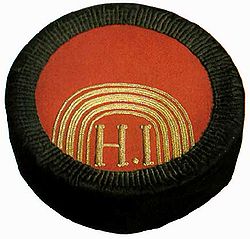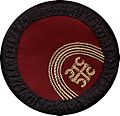 A Montenegrin cap with the initials N.I.of King Nicholas I of Montenegro A Montenegrin cap with the initials N.I.of King Nicholas I of Montenegro |
The Montenegrin cap (Serbian: Црногорска капа, romanized: Crnogorska kapa) is a cap traditionally worn in Montenegro by the Montenegrins and Serbs of Montenegro. It was introduced by Prince Bishop Petar II Petrović-Njegoš in the mid-1840s as a replacement for the then-popular fez.
Design and symbolism

The cap is originally in the shape of a flat cylinder, having a red upper surface (called tepelak) not dissimilar to the Herzegovina and Lika caps. Prince-Bishop Petar II Petrović-Njegoš wore it with a black rim (called derevija), and the definition given was as a sign of grief of occupied Kosovo. The Kosovo Myth was very popular in Montenegro. The enforcement of the cap upon the Montenegrin chieftains by Prince-Bishop Petar II was a mark of expression of then's dominating Serbian national identity.
The national telling recorded the most often version of the cap as following: the black wrapper was a sign of grief for their once great Serbian Empire, the red the symbol of spilled blood at the Battle of Kosovo and the five small stripes on the top represent the remaining remains of the once great Serbian realm, which became increasingly popular amongst the common folk during the reign of Prince Danilo I Petrović-Njegoš. Within the stripes is angled a six star, representing the last free part, Montenegro, shining upon the fallen and conquered.
During the Communist era in the second half of the 20th century instead of the Serb cross the Communist Red Star was implanted between the golden stripes, although it was not spread amongst the people and never accepted. Several years ago a new version appeared with a large modern (2004) Coat of Arms of Montenegro spread across the cap's red top, that is becoming increasingly popular as a sign of the Montenegrin nation's independence and sovereignty. A female version of the cap was introduced, so far worn almost exclusively by men.
History
The Montenegrin cap has a three-hundred-year history. A 1754 portrait of a Montenegrin from Paštrovići is the oldest representation of the Montenegrin cap, with the Paštrovići variant of the cap being all-black in color. The first representation of the cap in its modern, two-colour variety (black and red) is found on an aquarelle from 1782. Josef Holeček, on his journey through Montenegro in 1876, described a Montenegrin cap and its eagle motif.
Gallery
-
 A Montenegrin Orthodox Priest before battle wearing his cap, 1876
A Montenegrin Orthodox Priest before battle wearing his cap, 1876
-
 Montenegrin man, 19th Century
Montenegrin man, 19th Century
-
 Officers of the Royal Montenegrin Army wearing their caps, 1904
Officers of the Royal Montenegrin Army wearing their caps, 1904
-
 Montenegrin cap with the Serbian cross
Montenegrin cap with the Serbian cross
-
 These richly adorned caps were worn by King Nikola I (right) and his queen, Milena Vukotić
These richly adorned caps were worn by King Nikola I (right) and his queen, Milena Vukotić
See also
References
- Victor Roudometof (2001). Nationalism, Globalization, and Orthodoxy: The Social Origins of Ethnic Conflict in the Balkans. Greenwood Publishing Group. p. 128. ISBN 978-0-313-31949-5.
- Vuk Stefanović Karadžić (1837), Crna Gora i Crnogorci, Rastko
- Miodrag Vlahović (1953), "O najstarijoj kapi kod jugoslovena s obzirom na zbirku kapa etnografskog muzeja u Beogradu", Glasnik Etnografskog muzeja u Beogradu, Belgrade: Etnografski Muzej
- Andrija Jovićević (1903), Crna Gora, Narodni život i običaji
- Zorica Radulović (1976), "Crnogorska muška kapa", Glasnik Cetinjskih muzeja IX, Cetinje
- Jovan Vukmanović (1963), "Fizicki lik i izgled Njegosa", Glasnik Etnografskog muzeja na Cetinju, Cetinje
- Slobodan B. Medojević, Crnogorska Kapa, https://issuu.com/vijececg/docs/cg_glasnik_84 #page=52-53
- Mladen Zadrima, 2019, Crnogorska narodna nošnja kroz opise stranih putopisaca http://www.maticacrnogorska.me/files/78/21%20mladen%20zadrima%2078.pdf #page=389